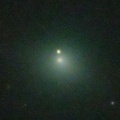
|
Now it is 8.7 mag (July 27, Marco Goiato). It will fade out rapidly after this. It will be unobservable in October.
Date(TT) R.A. (2000) Decl. Delta r Elong. m1 Best Time(A, h)
July 29 16 53.14 -47 15.0 0.626 1.484 127 8.2 20:44 ( 4, 8)
Aug. 5 15 49.40 -36 40.5 0.788 1.485 110 8.7 20:35 ( 21, 15)
|
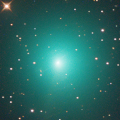
|
Now it is 9.4 mag (July 29, Osamu Miyazaki). It will fade out rapidly after this. It will be fainter than 18 mag in November. In the Northern Hemisphere, it stays observable in good condition. In the Southern Hemisphere, it is not observable now, but it will appear in August.
Date(TT) R.A. (2000) Decl. Delta r Elong. m1 Best Time(A, h)
July 29 20 37.26 69 40.2 0.457 1.124 91 9.4 0:10 (180, 55)
Aug. 5 21 10.87 60 38.3 0.414 1.174 102 9.5 0:18 (180, 64)
|

|
Now it is 9.8 mag (July 29, Marco Goiato). Fading slowly. In the Southern Hemisphere, it stays observable in good condition.
Date(TT) R.A. (2000) Decl. Delta r Elong. m1 Best Time(A, h)
July 29 3 11.51 6 23.5 2.406 2.415 78 9.7 3:28 (290, 36)
Aug. 5 3 9.21 3 28.7 2.293 2.447 86 9.7 3:35 (300, 41)
|

|
It brightened up to 8 mag from 2022 summer to 2023 spring. Now it is 11 mag (July 15, Michael Mattiazzo). It stays 12 mag for a while. In the Northern Hemisphere, it is not observable now, but it will appear in August. In the Southern Hemisphere, it will be getting higher gradually.
Date(TT) R.A. (2000) Decl. Delta r Elong. m1 Best Time(A, h)
July 29 6 25.31 -9 13.3 3.892 3.208 41 11.6 3:28 (273,-12)
Aug. 5 6 30.51 -8 53.0 3.912 3.271 44 11.6 3:35 (277, -6)
|

|
It is expected to brighten up to 7.5 mag in October. Now it is 13.1 mag (July 28, Osamu Miyazaki). Brightening rapidly. In the Northern Hemisphere, it stays observable in good condition. It locates somewhat low in the Southern Hemisphere. But it will become high in autumn. It is fainter than this ephemeris recently.
Date(TT) R.A. (2000) Decl. Delta r Elong. m1 Best Time(A, h)
July 29 0 1.55 27 56.8 0.750 1.461 110 12.3 3:28 (344, 83)
Aug. 5 0 23.71 31 20.2 0.674 1.403 110 11.8 3:31 ( 0, 86)
|
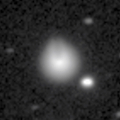
|
It returns for the first time in 70 years. It will brighten up to 4.5 mag in 2024 spring. It suddenly brightened in outburst by 5 mag up to 11.5 mag on July 20 (E. Tamas, Francois Kugel). Now it is 11.9 mag (July 29, Katsumi Yoshimoto). Fading slowly. In the Northern Hemisphere, it stays observable in good condition. In the Southern Hemisphere, it is not observable now, but it will appear in August.
Date(TT) R.A. (2000) Decl. Delta r Elong. m1 Best Time(A, h)
July 29 18 4.92 55 44.0 3.500 3.797 99 11.8 21:36 (180, 69)
Aug. 5 17 54.24 55 22.8 3.450 3.724 97 12.0 20:58 (180, 70)
|
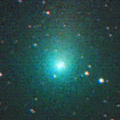
|
It brightened up to 9.5 mag from winter to early spring (Jan. 30, Katsumi Yoshimoto). Now it is 12.3 mag (July 29, Osamu Miyazaki). It will fade out rapidly after this. In the Northern Hemisphere, it stays observable in good condition. In the Southern Hemisphere, it will be getting higher gradually.
Date(TT) R.A. (2000) Decl. Delta r Elong. m1 Best Time(A, h)
July 29 0 39.99 28 39.2 2.228 2.653 103 11.9 3:28 (297, 78)
Aug. 5 0 31.52 26 45.1 2.166 2.715 112 12.0 3:35 (352, 82)
|
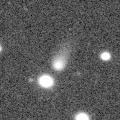
|
It is expected to brighten up to 7 mag in early 2024. Now it is 14.1 mag (June 19, Chris Wyatt). It will brighten rapidly after this. In the Northern Hemisphere, it is not observable now, but it will appear in November. It locates somewhat low in the Southern Hemisphere. But it will become high in winter. The brightness evolution slowed down since May.
Date(TT) R.A. (2000) Decl. Delta r Elong. m1 Best Time(A, h)
July 29 7 47.53 -24 34.5 3.639 3.005 44 12.6 3:28 (276,-37)
Aug. 5 8 0.34 -25 5.9 3.566 2.931 44 12.4 3:35 (280,-32)
|

|
Now it is 13.7 mag (July 14, Chris Wyatt). It stays 13 mag for a while. In the Northern Hemisphere, it is not observable now, but it will appear in October. In the Southern Hemisphere, it will be unobservable in August. But it will be observable again in September.
Date(TT) R.A. (2000) Decl. Delta r Elong. m1 Best Time(A, h)
July 29 10 24.04 -10 43.2 4.496 3.785 40 12.7 20:44 ( 87,-16)
Aug. 5 10 25.82 -11 38.7 4.576 3.803 36 12.8 20:35 ( 89,-20)
|
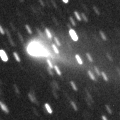
|
Now it is 12.6 mag (July 24, Osamu Miyazaki). It will fade out rapidly after this. It stays observable in good condition.
Date(TT) R.A. (2000) Decl. Delta r Elong. m1 Best Time(A, h)
July 29 19 35.71 0 50.4 1.106 2.076 156 12.7 23:08 ( 0, 56)
Aug. 5 19 32.05 0 51.4 1.141 2.092 152 12.9 22:37 ( 0, 56)
|
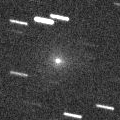
|
It was expected to brighten up to 11 mag in July. But actually, it is fainter than originally expected. Now it is 12.7 mag (July 15, Michael Mattiazzo). It will fade out rapidly after this. It will be fainter than 18 mag in October. It stays extremely low.
Date(TT) R.A. (2000) Decl. Delta r Elong. m1 Best Time(A, h)
July 29 6 11.80 20 3.1 1.643 0.961 32 12.9 3:28 (251, 8)
Aug. 5 6 42.29 18 33.7 1.688 0.991 32 13.1 3:35 (253, 8)
|

|
Now it is 13.1 mag (July 22, Chris Wyatt). Fading slowly. In the Northern Hemisphere, it is not observable now. It was expected to brighten up to 10 mag from spring to summer. However, it is fainter than originally expected.
Date(TT) R.A. (2000) Decl. Delta r Elong. m1 Best Time(A, h)
July 29 11 7.29 -80 53.9 2.806 3.174 101 12.9 20:44 ( 11,-35)
Aug. 5 11 8.44 -79 10.3 2.888 3.191 97 13.0 20:35 ( 13,-35)
|

|
It brightened up to 8.3 mag in 2021-2022 winter (Jan. 6, 2022, Toshiyuki Takahashi). Now it is 13.2 mag (July 14, Chris Wyatt). It stays 14 mag for a while. In the Northern Hemisphere, it is not observable now, but it will appear in November. It locates somewhat low in the Southern Hemisphere. But it will become high in autumn.
Date(TT) R.A. (2000) Decl. Delta r Elong. m1 Best Time(A, h)
July 29 9 56.38 -31 9.0 6.565 6.027 54 13.1 20:44 ( 72,-31)
Aug. 5 10 2.07 -31 34.4 6.656 6.071 51 13.2 20:35 ( 72,-34)
|
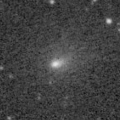
|
Now it is 14.0 mag (July 22, Thomas Lehmann). It will fade out rapidly after this. It will be fainter than 18 mag in November. In the Northern Hemisphere, it stays observable in good condition. In the Southern Hemisphere, it is not observable now, but it will appear in August.
Date(TT) R.A. (2000) Decl. Delta r Elong. m1 Best Time(A, h)
July 29 21 36.57 58 5.9 0.906 1.492 101 13.5 1:15 (180, 66)
Aug. 5 20 45.48 49 37.6 0.814 1.530 113 13.4 23:46 (180, 76)
|
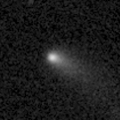
|
Now it is 13.8 mag (July 21, Ken-ichi Kadota). Fading slowly. In the Northern Hemisphere, it stays observable in good condition. In the Southern Hemisphere, it will be getting lower gradually after this, and it will be unobservable in September.
Date(TT) R.A. (2000) Decl. Delta r Elong. m1 Best Time(A, h)
July 29 2 23.07 23 0.5 1.504 1.730 84 13.7 3:28 (280, 55)
Aug. 5 2 29.73 27 27.1 1.451 1.743 88 13.6 3:35 (278, 63)
|
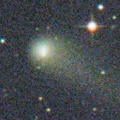
|
It brightened up to 11.1 mag in early 2022 (Mar. 31, 2022, F. Kugel, J.-G. Bosch, J. Nicolas). Now it is 13.0 mag (July 24, Osamu Miyazaki). Fading slowly. In the Northern Hemisphere, it stays observable in good condition. In the Southern Hemisphere, it will be getting lower gradually after this, and it will be unobservable in October.
Date(TT) R.A. (2000) Decl. Delta r Elong. m1 Best Time(A, h)
July 29 15 13.79 20 47.4 5.276 5.422 92 13.8 20:44 ( 69, 61)
Aug. 5 15 15.47 20 24.4 5.396 5.456 88 13.9 20:35 ( 72, 57)
|
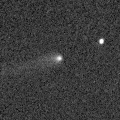
|
Now it is 14.6 mag (July 24, Toshihiko Ikemura, Hirohisa Sato). It stays 14 mag for a while. It stays observable in good condition.
Date(TT) R.A. (2000) Decl. Delta r Elong. m1 Best Time(A, h)
July 29 2 27.26 7 8.5 3.154 3.288 88 14.2 3:28 (299, 45)
Aug. 5 2 20.53 7 24.6 3.026 3.301 96 14.1 3:35 (310, 52)
|

|
It stays 14 mag for a while. Now it is not observable. It will appear in August.
Date(TT) R.A. (2000) Decl. Delta r Elong. m1 Best Time(A, h)
July 29 7 45.04 24 7.7 7.112 6.121 11 14.2 3:28 (234, -7)
Aug. 5 7 50.64 23 50.7 7.086 6.123 17 14.2 3:35 (239, -2)
|

|
Now it is 14.3 mag (July 7, Thomas Lehmann). Fading slowly. In the Northern Hemisphere, it is not observable now. It locates somewhat low in the Southern Hemisphere. But it will become high in winter.
Date(TT) R.A. (2000) Decl. Delta r Elong. m1 Best Time(A, h)
July 29 8 58.58 -44 12.7 2.561 2.295 63 14.3 20:44 ( 60,-46)
Aug. 5 9 25.03 -45 25.4 2.614 2.334 62 14.4 20:35 ( 58,-45)
|

|
It approached to Earth down to 0.29 a.u. in early February, and it brightened up to 4.5 mag (Feb. 1, Juan Jose Gonzalez). Now it is 14.3 mag (July 18, Hidetaka Sato). Fading slowly. In the Northern Hemisphere, it is not observable now, but it will appear in September. In the Southern Hemisphere, it stays observable in good condition.
Date(TT) R.A. (2000) Decl. Delta r Elong. m1 Best Time(A, h)
July 29 6 24.80 -27 34.5 3.460 3.006 55 14.5 3:28 (289,-22)
Aug. 5 6 28.88 -29 30.9 3.482 3.084 58 14.6 3:35 (295,-17)
|

|
Now it is 14.5 mag (July 24, Toshihiko Ikemura, Hirohisa Sato). Fading gradually. In the Southern Hemisphere, it stays observable in good condition.
Date(TT) R.A. (2000) Decl. Delta r Elong. m1 Best Time(A, h)
July 29 16 56.10 -19 26.0 1.806 2.575 129 14.6 20:44 ( 4, 35)
Aug. 5 16 57.58 -19 42.1 1.918 2.616 123 14.8 20:35 ( 9, 35)
|

|
Now it is 14.5 mag (July 17, L. Grazzini). Fading slowly. It locates somewhat low in the Northern Hemisphere. In the Southern Hemisphere, it stays observable in good condition.
Date(TT) R.A. (2000) Decl. Delta r Elong. m1 Best Time(A, h)
July 29 17 55.24 -29 7.0 2.033 2.911 143 14.6 21:28 ( 0, 26)
Aug. 5 17 53.36 -29 56.3 2.093 2.910 136 14.7 20:59 ( 0, 25)
|

|
Now it is 14.8 mag (July 17, Toshihiko Ikemura, Hirohisa Sato). It stays 15 mag for a while. It will be getting lower gradually after this, and it will be unobservable in October. It is expected to brighten up to 12.5 mag in 2024 spring. At the high light, it will be observable in excellent condition in the Southern Hemisphere, but it will be low in the Northern Hemisphere.
Date(TT) R.A. (2000) Decl. Delta r Elong. m1 Best Time(A, h)
July 29 15 37.06 14 7.8 3.226 3.555 100 14.7 20:44 ( 51, 60)
Aug. 5 15 29.41 12 24.4 3.296 3.511 93 14.7 20:35 ( 58, 54)
|
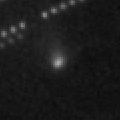
|
It brightened very rapidly. Now it is 14.9 mag (July 13, Taras Prystavski). Fading gradually. In the Northern Hemisphere, it is not observable now, but it will appear in November. In the Southern Hemisphere, it will be getting lower gradually after this, and it will be unobservable in October.
Date(TT) R.A. (2000) Decl. Delta r Elong. m1 Best Time(A, h)
July 29 13 54.74 -47 38.1 1.698 2.097 98 14.7 20:44 ( 31, -3)
Aug. 5 13 52.02 -42 3.8 1.818 2.079 89 14.7 20:35 ( 37, -2)
|
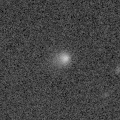
|
Now it is 15.6 mag (July 8, Thomas Lehmann). Brightening slowly. Now it is not observable. It will appear in September. It is expected to brighten up to 12 mag from 2024 to 2025.
Date(TT) R.A. (2000) Decl. Delta r Elong. m1 Best Time(A, h)
July 29 9 12.12 2 39.8 6.079 5.130 19 15.0 20:44 (110,-22)
Aug. 5 9 15.09 2 54.5 6.064 5.090 14 14.9 20:35 (113,-25)
|
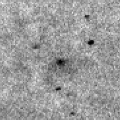
|
It brightened up to 12.8 mag in spring (Mar. 8, Taras Prystavski). Now it is 15.5 mag (July 23, Thomas Lehmann). Fading gradually. It stays observable in good condition.
Date(TT) R.A. (2000) Decl. Delta r Elong. m1 Best Time(A, h)
July 29 1 31.09 -2 8.5 1.811 2.292 104 15.1 3:28 (323, 46)
Aug. 5 1 33.68 -2 9.8 1.769 2.330 110 15.2 3:35 (334, 50)
|

|
The ATLAS search program detected its cometary activity in April. It continues to be brightening even after the perihelion passage. Now it is 14.2 mag (July 24, Hidetaka Sato). Fading slowly. It locates somewhat low in the Northern Hemisphere. But it will become high in autumn. In the Southern Hemisphere, it stays observable in good condition.
Date(TT) R.A. (2000) Decl. Delta r Elong. m1 Best Time(A, h)
July 29 0 0.83 -25 31.9 2.067 2.841 131 15.1 3:28 (358, 30)
Aug. 5 0 1.40 -25 58.0 2.040 2.864 136 15.1 3:10 ( 0, 29)
|

|
It will brighten up to 14 mag from 2024 to 2025. Now it is 15.2 mag (July 22, ATLAS Chile). It stays 15 mag for a while. In the Northern Hemisphere, it is not observable now, but it will appear in October. It locates somewhat low in the Southern Hemisphere. But it will become high in autumn.
Date(TT) R.A. (2000) Decl. Delta r Elong. m1 Best Time(A, h)
July 29 9 52.21 -26 49.2 6.471 5.868 49 15.2 20:44 ( 77,-30)
Aug. 5 9 58.93 -26 52.2 6.493 5.841 46 15.2 20:35 ( 78,-33)
|

|
Now it is 15.7 mag (July 16, Hiroshi Abe). It stays 16 mag for a while. It stays observable in good condition.
Date(TT) R.A. (2000) Decl. Delta r Elong. m1 Best Time(A, h)
July 29 0 49.06 -4 54.5 2.980 3.540 115 15.3 3:28 (338, 48)
Aug. 5 0 49.45 -5 4.0 2.910 3.555 122 15.2 3:35 (351, 50)
|

|
It has not been observed yet in this apparition. It was expected to brighten rapidly up to 15 mag in summer. But actually, it is not detected, fainter than 18.5 mag (July 18, Martin Masek). It stays 16 mag for a while. It locates somewhat low in the Northern Hemisphere. In the Southern Hemisphere, it stays observable in good condition.
Date(TT) R.A. (2000) Decl. Delta r Elong. m1 Best Time(A, h)
July 29 16 42.58 -31 57.0 1.364 2.139 127 15.5 20:44 ( 6, 23)
Aug. 5 16 45.41 -31 4.6 1.406 2.120 121 15.3 20:35 ( 10, 23)
|

|
It will brighten up to 7.5 mag in October. Now it is 14.4 mag (July 29, Katsumi Yoshimoto). Brightening rapidly. It will be unobservable in September in the Southern Hemisphere, or in October in the Northern Hemisphere.
Date(TT) R.A. (2000) Decl. Delta r Elong. m1 Best Time(A, h)
July 29 3 41.55 28 0.8 1.745 1.623 66 16.3 3:28 (261, 41)
Aug. 5 4 3.79 29 35.2 1.599 1.533 67 15.5 3:35 (261, 45)
|
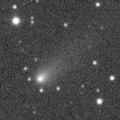
|
Now it is 15.1 mag (July 22, Thomas Lehmann). Fading gradually. In the Northern Hemisphere, it will be unobservable in September. In the Southern Hemisphere, it stays observable in good condition.
Date(TT) R.A. (2000) Decl. Delta r Elong. m1 Best Time(A, h)
July 29 13 53.95 -34 54.1 2.191 2.471 93 15.5 20:44 ( 38, 6)
Aug. 5 14 3.15 -35 25.7 2.282 2.486 89 15.7 20:35 ( 40, 5)
|

|
It will approach to Sun down to 0.4 a.u. in late September in 2024, and it is expected to brighten up to 0 mag. Now it is 16.3 mag (July 16, Ken-ichi Kadota). Brightening slowly. It will be getting lower gradually after this, and it will be unobservable in October. But it will be observable again in November in the Northern Hemisphere. At the high light, in the Northern Hemisphere, it will be observable in good condition after the perihelion passage. In the Southern Hemisphere, it will be observable in the low sky before and after the perihelion passage.
Date(TT) R.A. (2000) Decl. Delta r Elong. m1 Best Time(A, h)
July 29 14 3.73 2 10.3 5.910 5.872 82 16.0 20:44 ( 63, 36)
Aug. 5 14 3.10 1 49.1 5.958 5.804 76 16.0 20:35 ( 67, 32)
|
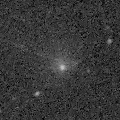
|
Very large comet. It is expected to brighten up to 13 mag in 2031. Now it is 15.9 mag (July 23, Thomas Lehmann). It stays 16 mag for a while. In the Northern Hemisphere, it is not observable now. In the Southern Hemisphere, it stays observable in good condition. In the Northern Hemisphere, it is not observable until 2030.
Date(TT) R.A. (2000) Decl. Delta r Elong. m1 Best Time(A, h)
July 29 3 29.71 -60 17.7 17.207 17.401 99 16.4 3:28 (335,-15)
Aug. 5 3 31.22 -60 44.3 17.155 17.376 100 16.4 3:35 (339,-13)
|

|
Now it is 16.2 mag (July 28, ATLAS Chile). Fading gradually. It will be fainter than 18 mag in October. It stays observable in good condition. It was very faint as 21.5 mag in 2021. It seems to be bright temporarily in outburst.
Date(TT) R.A. (2000) Decl. Delta r Elong. m1 Best Time(A, h)
July 29 21 34.15 -10 32.1 3.461 4.440 162 16.5 1:11 ( 0, 45)
Aug. 5 21 30.38 -10 41.6 3.451 4.453 169 16.6 0:40 ( 0, 44)
|

|
It brightened up to 13.4 mag in last summer (July 7, 2022, Giuseppe Pappa). Now it is 16.3 mag (July 17, Toshihiko Ikemura, Hirohisa Sato). Fading slowly. In the Northern Hemisphere, it stays observable in good condition. In the Southern Hemisphere, it will be unobservable in October.
Date(TT) R.A. (2000) Decl. Delta r Elong. m1 Best Time(A, h)
July 29 15 27.53 33 17.7 4.104 4.243 90 16.5 20:44 ( 93, 69)
Aug. 5 15 23.97 32 51.5 4.238 4.289 86 16.6 20:35 ( 94, 64)
|

|
It will approach to Sun down to 0.05 a.u. on Aug. 21, and it will brighten up to 5.5 mag. It will turn to fade out rapidly after brightening. It will be fainter than 18 mag in September. In the Northern Hemisphere, it will never be observable after this. In the Southern Hemisphere, it will be getting lower gradually after this, and it will be unobservable in August.
Date(TT) R.A. (2000) Decl. Delta r Elong. m1 Best Time(A, h)
July 29 11 26.05 -8 41.4 0.816 0.813 51 17.6 20:44 ( 81, -2)
Aug. 5 11 8.81 -4 6.5 0.821 0.635 38 16.5 20:35 ( 90, -7)
|
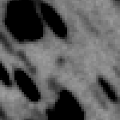
|
Now it is 16.7 mag (July 20, Taras Prystavski). It stays 17 mag for a while. It stays observable in good condition.
Date(TT) R.A. (2000) Decl. Delta r Elong. m1 Best Time(A, h)
July 29 17 44.45 -10 28.7 1.833 2.684 139 16.6 21:17 ( 0, 45)
Aug. 5 17 42.57 -10 31.4 1.874 2.664 132 16.6 20:48 ( 0, 44)
|

|
Very far object. Now it is 17.3 mag (July 23, ATLAS South Africa). It stays 17 mag for a while. In the Northern Hemisphere, it is not observable now. In the Southern Hemisphere, it stays observable in good condition.
Date(TT) R.A. (2000) Decl. Delta r Elong. m1 Best Time(A, h)
July 29 5 43.96 -68 48.4 10.232 10.330 92 16.8 3:28 (335,-32)
Aug. 5 5 46.17 -69 18.1 10.227 10.327 92 16.8 3:35 (337,-29)
|

|
It brightened up to 14.1 mag in 2022 spring (Mar. 22, 2022, Chris Wyatt). It was expected to brighten up to 13 mag. But actually, it was fainter than originally expected. Now it is 16.3 mag (July 21, Ken-ichi Kadota). It stays 17 mag for a while. It stays observable in good condition.
Date(TT) R.A. (2000) Decl. Delta r Elong. m1 Best Time(A, h)
July 29 3 6.35 -2 55.9 4.919 4.892 82 16.9 3:28 (299, 31)
Aug. 5 3 5.29 -2 46.6 4.849 4.938 89 16.9 3:35 (307, 37)
|

|
It is expected to brighten up to 14 mag in winter. Now it is 17.8 mag (July 6, John Maikner). Brightening gradually. It stays observable in good condition.
Date(TT) R.A. (2000) Decl. Delta r Elong. m1 Best Time(A, h)
July 29 2 52.99 11 17.9 2.986 3.003 81 17.1 3:28 (289, 43)
Aug. 5 2 59.93 11 51.7 2.857 2.965 86 16.9 3:35 (294, 48)
|

|
Now it is 16.8 mag (July 25, Jean-Claude Merlin). It stays 17 mag for a while. In the Northern Hemisphere, it will be unobservable in October. In the Southern Hemisphere, it stays observable in good condition. It stays 16 mag in the Southern sky for a long time from 2024 to 2025.
Date(TT) R.A. (2000) Decl. Delta r Elong. m1 Best Time(A, h)
July 29 16 52.84 -41 1.6 5.931 6.616 128 17.1 20:44 ( 3, 14)
Aug. 5 16 46.46 -40 51.6 5.997 6.585 121 17.1 20:35 ( 8, 13)
|

|
It approached to Earth down to 0.12 a.u. in April, and brightened up to 11.5 mag (Apr. 8, Osamu Miyazaki). Now it is 15.6 mag (July 16, Ken-ichi Kadota). Fading rapidly. It will be fainter than 18 mag in August. It stays observable in good condition.
Date(TT) R.A. (2000) Decl. Delta r Elong. m1 Best Time(A, h)
July 29 2 38.28 0 6.4 0.978 1.387 88 17.1 3:28 (303, 38)
Aug. 5 2 40.65 0 18.9 0.983 1.461 94 17.4 3:35 (311, 43)
|

|
It is expected to brighten up to 14 mag in 2024 summer. At the high light, it is not observable in the Northern Hemisphere. Now it is 18.2 mag (July 15, ATLAS Chile). Brightening slowly. It stays observable in good condition.
Date(TT) R.A. (2000) Decl. Delta r Elong. m1 Best Time(A, h)
July 29 3 25.67 6 33.7 4.607 4.452 74 17.3 3:28 (287, 33)
Aug. 5 3 28.09 5 34.4 4.442 4.402 81 17.2 3:35 (294, 39)
|
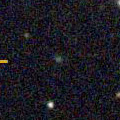
|
Now it is 17.4 mag (Feb. 16, Toshihiko Ikemura, Hirohisa Sato). It stays 17 mag for a while. In the Northern Hemisphere, it stays observable in good condition. It stays extremely low in the Southern Hemisphere.
Date(TT) R.A. (2000) Decl. Delta r Elong. m1 Best Time(A, h)
July 29 4 32.41 36 4.8 7.304 6.768 54 17.3 3:28 (247, 34)
Aug. 5 4 37.24 36 28.8 7.209 6.761 60 17.2 3:35 (249, 40)
|
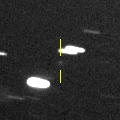
|
First return of a new periodic comet which brightened up to 15 mag in 2008. Now it is 17.7 mag (July 25, J. L. Virlichie, P. Traverse, H. Roy). Fading slowly. It will be fainter than 18 mag in November. In the Northern Hemisphere, it stays observable in good condition.
Date(TT) R.A. (2000) Decl. Delta r Elong. m1 Best Time(A, h)
July 29 3 10.78 22 44.7 2.511 2.433 73 17.4 3:28 (272, 45)
Aug. 5 3 21.18 22 33.6 2.447 2.452 78 17.4 3:35 (276, 50)
|

|
Now it is 17.4 mag (July 25, ATLAS Chile). It stays 17 mag for a while. In the Northern Hemisphere, it will be getting higher gradually. In the Southern Hemisphere, it stays observable in good condition.
Date(TT) R.A. (2000) Decl. Delta r Elong. m1 Best Time(A, h)
July 29 4 41.81 -9 0.3 8.175 7.766 62 17.5 3:28 (288, 9)
Aug. 5 4 45.02 -9 7.4 8.059 7.733 67 17.4 3:35 (293, 15)
|

|
Now it is 17.6 mag (July 17, Toshihiko Ikemura, Hirohisa Sato). It stays 18 mag for a while. In the Northern Hemisphere, it stays observable in good condition. It stays extremely low in the Southern Hemisphere.
Date(TT) R.A. (2000) Decl. Delta r Elong. m1 Best Time(A, h)
July 29 14 2.51 40 41.7 3.037 2.899 72 17.5 20:44 (113, 53)
Aug. 5 14 12.60 38 44.4 3.072 2.898 70 17.5 20:35 (110, 51)
|

|
It returns for the first time in 68 years. It will brighten up to 7.5 mag in 2024 summer. It has not been observed yet in this apparition. It will brighten rapidly after this. In the Northern Hemisphere, it will be getting higher gradually. In the Southern Hemisphere, it stays observable in good condition. At the high light, it locates low in the Northern Hemisphere, or it is not observable in the Southern Hemisphere.
Date(TT) R.A. (2000) Decl. Delta r Elong. m1 Best Time(A, h)
July 29 4 4.44 -13 49.1 4.436 4.257 73 17.7 3:28 (297, 13)
Aug. 5 4 9.19 -14 0.6 4.289 4.192 77 17.5 3:35 (303, 18)
|

|
It brightened up to 13.6 mag in 2021 (June 17, 2021, R. Carstens). Now it is 17.3 mag (June 9, D. Husar, M. Junius, S. Messner). It stays 18 mag for a while. In the Northern Hemisphere, it will never be observable after this. In the Southern Hemisphere, it will be getting lower gradually.
Date(TT) R.A. (2000) Decl. Delta r Elong. m1 Best Time(A, h)
July 29 11 4.02 -61 4.1 6.873 6.872 85 17.6 20:44 ( 34,-31)
Aug. 5 11 6.50 -60 38.4 6.974 6.906 82 17.7 20:35 ( 35,-33)
|

|
Now it is 17.9 mag (July 16, Toshihiko Ikemura, Hirohisa Sato). It stays 18 mag for a while. It stays observable in good condition.
Date(TT) R.A. (2000) Decl. Delta r Elong. m1 Best Time(A, h)
July 29 3 19.39 8 55.3 3.059 2.976 75 17.8 3:28 (286, 36)
Aug. 5 3 26.91 9 1.4 2.978 2.983 80 17.8 3:35 (291, 42)
|
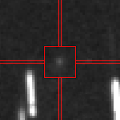
|
Now it is 17.7 mag (July 4, Observatoire SADR, Poroto). It stays 18 mag for a while. It stays observable in good condition.
Date(TT) R.A. (2000) Decl. Delta r Elong. m1 Best Time(A, h)
July 29 23 12.20 -10 59.5 2.185 3.037 140 17.9 2:48 ( 0, 44)
Aug. 5 23 11.01 -11 52.9 2.134 3.038 147 17.9 2:20 ( 0, 43)
|

|
Now it is 17.8 mag (July 16, Yasukazu Ikari). It stays 18 mag for a while. In the Northern Hemisphere, it stays observable in good condition. In the Southern Hemisphere, it will never be observable after this.
Date(TT) R.A. (2000) Decl. Delta r Elong. m1 Best Time(A, h)
July 29 14 45.55 77 46.7 10.400 10.138 72 17.9 20:44 (170, 44)
Aug. 5 14 39.99 77 11.1 10.420 10.157 72 17.9 20:35 (168, 44)
|
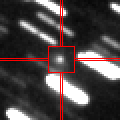
|
It showed cometary activity in 2023, and brightened rapidly. It brightened up to 17.3 mag in spring (May 8, ATLAS South Africa). Now it is 18.1 mag (July 25, Jean-Claude Merlin). Fading slowly. It will be fainter than 18 mag in August. It stays extremely low in the Northern Hemisphere. In the Southern Hemisphere, it stays observable in good condition.
Date(TT) R.A. (2000) Decl. Delta r Elong. m1 Best Time(A, h)
July 29 14 31.24 -38 5.9 3.102 3.453 101 17.9 20:44 ( 30, 8)
Aug. 5 14 37.22 -37 36.6 3.197 3.461 96 18.0 20:35 ( 33, 7)
|

|
It brightened up to 12.7 mag in last year (Feb. 27, 2022, Jose Guilherme de S. Aguiar). Now it is 17.5 mag (July 24, Toshihiko Ikemura, Hirohisa Sato). Fading gradually. It will be fainter than 18 mag in August. It locates somewhat low in the Northern Hemisphere. In the Southern Hemisphere, it stays observable in good condition.
Date(TT) R.A. (2000) Decl. Delta r Elong. m1 Best Time(A, h)
July 29 19 25.90 -27 13.1 2.231 3.216 162 17.9 22:59 ( 0, 28)
Aug. 5 19 20.88 -27 16.5 2.291 3.241 155 18.1 22:26 ( 0, 28)
|
|
![]()
 2P/Encke
2P/Encke 77P/Longmore
77P/Longmore C/2023 A3 ( Tsuchinshan-ATLAS )
C/2023 A3 ( Tsuchinshan-ATLAS ) C/2014 UN271 ( Bernardinelli-Bernstein )
C/2014 UN271 ( Bernardinelli-Bernstein ) P/2023 M4 ( ATLAS )
P/2023 M4 ( ATLAS ) C/2020 R7 ( ATLAS )
C/2020 R7 ( ATLAS ) 322P/SOHO
322P/SOHO 219P/LINEAR
219P/LINEAR C/2019 E3 ( ATLAS )
C/2019 E3 ( ATLAS ) C/2020 Y2 ( ATLAS )
C/2020 Y2 ( ATLAS ) 32P/Comas Sola
32P/Comas Sola C/2023 F3 ( ATLAS )
C/2023 F3 ( ATLAS ) 364P/PanSTARRS
364P/PanSTARRS C/2022 S4 ( Lemmon )
C/2022 S4 ( Lemmon ) C/2021 S4 ( Tsuchinshan )
C/2021 S4 ( Tsuchinshan ) 465P/2023 L1 ( Hill )
465P/2023 L1 ( Hill ) C/2022 QE78 ( ATLAS )
C/2022 QE78 ( ATLAS ) C/2022 U4 ( Bok )
C/2022 U4 ( Bok ) 13P/Olbers
13P/Olbers C/2018 U1 ( Lemmon )
C/2018 U1 ( Lemmon ) 170P/Christensen
170P/Christensen 287P/Christensen
287P/Christensen C/2019 O3 ( Palomar )
C/2019 O3 ( Palomar ) 464P/PanSTARRS
464P/PanSTARRS 116P/Wild 4
116P/Wild 4![]()
















































